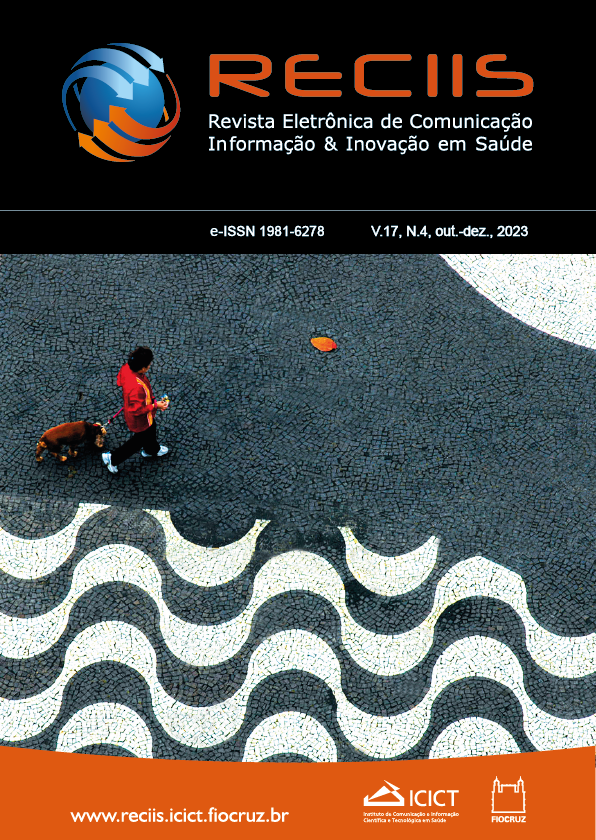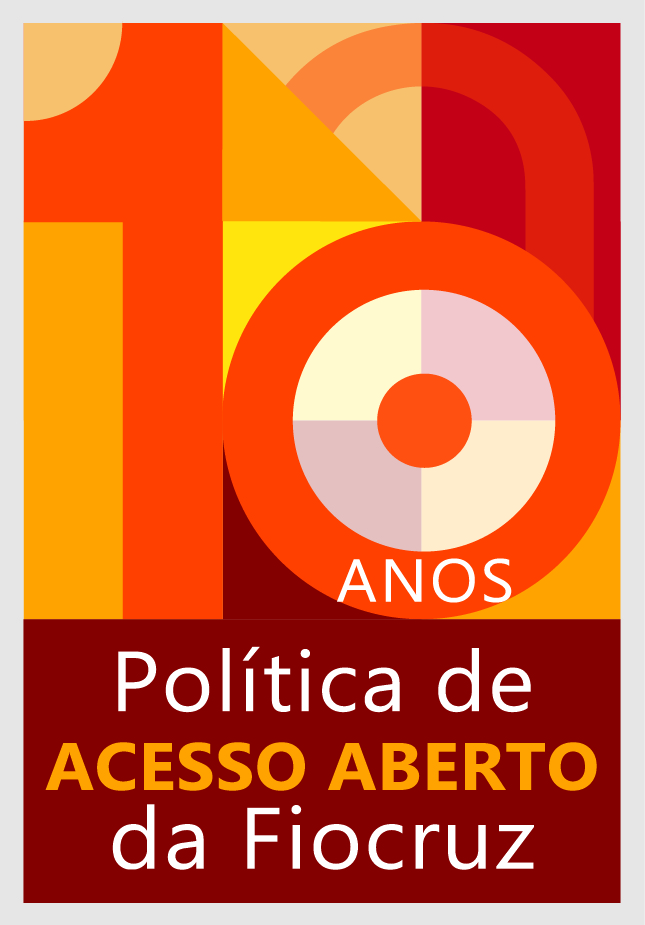The long-term user experience of an m-Health application
DOI:
https://doi.org/10.29397/reciis.v17i4.3828Palavras-chave:
Saúde digital, Autocuidado, Experiência do usuário, m-Health, EngajamentoResumo
Low user engagement in m-Health applications has been driving the use of retention techniques that aim to ensure a satisfactory long-term user experience. The aim was to understand the experience of hypertensive patients interacting with a mobile health application for 12 months. A qualitative/exploratory study was conducted after 12 months, with the same experimental group of participants as the non-randomized controlled clinical trial conducted in 2019. The mean age of the 16 participants was 57 years (SD=8), of which11 were female. All had low socioeconomic and educational levels. Content analysis showed no engagement with the m-health app over time. The main factors contributing to the lack of engagement were; inability of the user to use the app, lack of support and technical problems. When designing m-Health interventions, it is important to understand users' behavioral characteristics, motivations for treatment, level of involvement in health care, and ability to use technology.
Referências
ALBINI, Fabio et al. An ICT and mobile health integrated approach to optimize patients’ education on hypertension and its management by physicians: The Patients Optimal Strategy of Treatment (POST) pilot study. In: ANNUAL INTERNATIONAL CONFERENCE OF THE IEEE ENGINEERING IN MEDICINE AND BIOLOGY SOCIETY, 38., 16-20 Aug. 2016, Orlando. Proceedings [...] Orlando: IEEE, 2016. DOI: https://doi.org/10.1109/EMBC.2016.7590753. Available from: https://ieeexplore.ieee.org/document/7590753. Accessed: 15 Feb. 2022.
AMAGAI, Saki et al. Challenges in participant engagement and retention using mobile health apps: literature review. Journal of Medical Internet Research, Toronto, v. 24, n. 4, p. e35120, 2022. DOI: https://doi.org/10.2196/35120. Available from: https://www.jmir.org/2022/4/e35120. Accessed: 20 Mar. 2022.
ASHOORKHANI, Mahnaz et al. Comparing the effectiveness of the BPMAP (Blood Pressure Management Application) and usual care in self-management of primary hypertension and adherence to treatment in patients aged 30-60 years: study protocol for a randomized controlled trial. Trials, London, v. 17, n. 1, p. 511, 21 dez. 2016. DOI: https://doi.org/10.1186/s13063-016-1638-0. Available from: https://trialsjournal.biomedcentral.com/articles/10.1186/s13063-016-1638-0. Accessed: 17 Mar. 2022.
ASSMANN, Márcia Prante; ZANATTA, Alexandre Lazaretti; DE MARCHI, Ana Carolina Bertoletti. Long-term user experience in software crowdsourcing platform. In: BRAZILIAN SYMPOSIUM ON HUMAN FACTORS IN COMPUTING SYSTEMS, 20., 2021, online. Proceedings […]. New York: Association for Computing Machinery, 2021. p. 1-7. DOI: https://doi.org/10.1145/3472301.3484342. Available from: https://doi.org/10.1145/3472301.3484342. Accessed: 12 Jun. 2022.
BAIG, Mirza Mansoor; GHOLAMHOSSEINI, Hamid; AHMAD, Farhan. A usability and user-experience analysis of VitalsAssist: a mHealth application to monitor vital signs in acute care settings. In: ANNUAL INTERNATIONAL CONFERENCE OF THE IEEE ENGINEERING IN MEDICINE AND BIOLOGY SOCIETY, 42., 2020, Montreal. Proceedings […]. Orlando: IEEE, 2020. p. 5132-5135. DOI: https://doi.org/10.1109/EMBC44109.2020.9176467. Available from: https://doi.org/10.1109/EMBC44109.2020.9176467. Accessed: 14 Jul. 2022.
BARDIN, Laurence. Análise de conteudo. 5. ed. Coimbra: Edições 70, 2008.
BARRETO, Ivana Cristina de Holanda Cunha et al. Desenvolvimento e avaliação do protótipo da aplicação GISSA ChatBot Mamãe-Bebê para promoção da saúde infantil. Ciência & Saúde Coletiva, Rio de Janeiro, v. 26, n. 5, p. 1679-1690, 2021. DOI: https://doi.org/10.1590/1413-81232021265.04072021. Available from: https://www.scielo.br/j/csc/a/HGwWTZGbC5zfHXsTqNFkYnM/?lang=pt. Accessed: 14 Mar. 2022.
BIDUSKI, Daiana et al. Assessing long-term user experience on a mobile health application through an in-app embedded conversation-based questionnaire. Computers in Human Behavior, [s. l.], v. 104, p. 1-15, 2020. DOI: https://doi.org/10.1016/j.chb.2019.106169. Available from: https://www.sciencedirect.com/science/article/pii/S0747563219303814. Accessed: 25 Feb. 2022.
CECHETTI, Nathália Pinto et al. Developing and implementing a gamification method to improve user engagement: A case study with an m-Health application for hypertension monitoring. Telematics and Informatics, [s. l.], v. 41, p. 126-138, 2019. DOI: https://doi.org/10.1016/J.TELE.2019.04.007. Available from: https://www.sciencedirect.com/science/article/pii/S0736585318312656?via%3Dihub. Accessed: 21 Feb. 2022.
CONROY, David E.; KIM, Ian. HeartPhone: mobile evaluative conditioning to enhance affective processes and promote physical activity. Health Psychology, State College, v. 40, n. 12, p. 988-997, 2021. DOI: https://doi.org/10.1037/hea0000886. Available from: https://psycnet.apa.org/doiLanding?doi=10.1037%2Fhea0000886. Accessed: 13 Mar. 2022.
CUNHA, Bruna C. R.; RODRIGUES, Kamila R. H.; PIMENTEL, Maria da Graça C. Synthesizing guidelines for facilitating elderly-smartphone interaction. In: BRAZILLIAN SYMPOSIUM ON MULTIMEDIA AND THE WEB, 25., 2019, Rio de Janeiro. Proceedings […]. New York: Association for Computing Machinery, 2019. p. 37-44. DOI: https://doi.org/10.1145/3323503.3349563. Available from: https://dl.acm.org/doi/10.1145/3323503.3349563. Accessed: 5 Apr 2022.
DE MARCHI, Ana Carolina Bertoletti et al. An electronic health platform for monitoring health conditions of patients with hypertension in the Brazilian public health system: Protocol for a nonrandomized controlled trial. JMIR Research Protocols, Toronto, v. 9, n. 1, p. e15299, 20 jan. 2020. DOI: https://doi.org/10.2196/15299. Available from: https://www.researchprotocols.org/2020/1/e15299/. Accessed: 10 Feb. 2022.
FRANÇA, Maria Luísa Fagundes et al. Suporte ao enfrentamento das doenças crônicas realizado pelo Núcleo de Telessaúde de Santa Catarina. Brazilian Applied Science Review, São José dos Pinhais, v. 4, n. 4, p. 2187-2203, 2020. DOI: https://doi.org/10.34115/basrv4n4-006. Available from: https://ojs.brazilianjournals.com.br/ojs/index.php/BASR/article/view/12808. Accessed: 23 Apr. 2022.
GIASSI, Beatriz Hencklein; SEABRA, Rodrigo Duarte. Usability assessment of the Instagram application on smartphones with emphasis on elderly users. In: BRAZILIAN SYMPOSIUM ON HUMAN FACTORS IN COMPUTING SYSTEMS, 18., 2019, Rio de Janeiro. Proceedings […]. New York: Association for Computing Machinery, 2019. p. 1-4. DOI: https://doi.org/10.1145/3357155.3360470. Available from: https://dl.acm.org/doi/10.1145/3323503.3349563. Accessed: 7 Mar. 2022.
GUIMARÃES, Cayley; DOS SANTOS, Leandro Augusto Ferras; FONTANA, Isabela Mantovani. Design & Engenharia de Usabilidade: aplicação prática na criação de um aplicativo. Design e Tecnologia, Porto Alegre, v. 7, n. 14, p. 11-29, 2017. DOI: https://doi.org/10.23972/det2017iss14pp11-29. Available from: https://www.ufrgs.br/det/index.php/det/article/view/420. Accessed: 15 Feb 2022.
HASSENZAHL, Marc; TRACTINSKY, Noam. User experience: a research agenda. Behaviour and Information Technology, [s. l.], v. 25, n. 2, p. 91-97, 2006. DOI: https://doi.org/10.1080/01449290500330331. Available from: https://www.tandfonline.com/doi/abs/10.1080/01449290500330331. Accessed: 12 Mar. 2022.
JEFFREY, Bronte et al. Mobile phone applications and their use in the self-management of Type 2 Diabetes Mellitus: a qualitative study among app users and non-app users. Diabetology & Metabolic Syndrome, London, v. 11, n. 1, 2019. DOI: https://doi.org/10.1186/S13098-019-0480-4. Available from: https://dmsjournal.biomedcentral.com/articles/10.1186/s13098-019-0480-4. Accessed: 26 Feb. 2022.
KANE, Lexie. The peak-end rule: how impressions become memories. Nielsen Norman Group, Dover, 30 Dec. 2018. Available from: https://www.nngroup.com/articles/peak-end-rule/. Accessed: 11 Jan. 2023.
KIM, Jane Park; HWANG, Jisung; TREGARTHEN, Jenna. Engagement patterns of users and providers: a study of messaging on app usage in a smartphone app for the treatment of eating disorders. Journal of Technology in Behavioral Science, [s. l.], v. 6, n. 4, p. 572-577, 2021. DOI: https://doi.org/10.1007/s41347-021-00220-8. Available from: https://link.springer.com/article/10.1007/s41347-021-00220-8. Accessed: 9 Mar. 2022.
KIM, Jina; PARK, Eunil. Beyond coolness: predicting the technology adoption of interactive wearable devices. Journal of Retailing and Consumer Services, [s. l.], v. 49, p. 114-119, 2019. DOI: https://doi.org/10.1016/j.jretconser.2019.03.013. Available from: https://www.sciencedirect.com/science/article/abs/pii/S0969698918309044?via%3Dihub. Accessed: 26 Feb. 2022.
KIM, Meelin et al. Multidimensional cognitive behavioral therapy for obesity applied by psychologists using a digital platform: open-label randomized controlled trial. JMIR Mhealth Uhealth, v. 8, n. 4, p. e14817, 2020. DOI: https://doi.org/10.2196/14817. Available from: https://mhealth.jmir.org/2020/4/e14817. Accessed: 20 Mar. 2022.
KIM, Sunyoung. Exploring how older adults use a smart speaker-based voice assistant in their first interactions: qualitative study. JMIR mHealth and uHealth, Toronto, v. 9, n. 1, p. e20427, 2021. DOI: https://doi.org/10.2196/20427. Available from: https://mhealth.jmir.org/2021/1/e20427/. Accessed: 18 Apr. 2022.
KOWALSKI, Jaroslav et al. Older adults and voice interaction: a pilot study with Google Home. In: CONFERENCE ON HUMAN FACTORS IN COMPUTING SYSTEMS, 2019, Glasgow. Proceedings […]. New York: Association for Computing Machinery, 2019. p. 1-6. DOI: https://doi.org/10.1145/3290607.3312973. Available from: https://dl.acm.org/doi/10.1145/3290607.3312973. Accessed: 19 Mar. 2022.
KUJALA, Sari et al. Identifying hedonic factors in long-term user experience. In: 2011 CONFERENCE ON DESIGNING PLEASURABLE PRODUCTS AND INTERFACES, 2011, Milano. Proceedings […]. New York: Association for Computing Machinery, 2012. p. 1-8. DOI: https://doi.org/10.1145/2347504.2347523. Available from: https://dl.acm.org/doi/10.1145/2347504.2347523. Accessed: 31 Oct. 2023.
LIANG, Jun et al. Chinese mobile health APPs for hypertension management: a systematic evaluation of usefulness. Journal of Healthcare Engineering, Essex, v. 2018, p. 1-14, 2018. DOI: https://doi.org/10.1155/2018/7328274. Available from: https://www.hindawi.com/journals/jhe/2018/7328274/. Accessed: 12 Feb. 2022.
LU, Xiomei et al. Interactive mobile health intervention and blood pressure management in adults: A meta-analysis of randomized controlled trials. Hypertension, Hagerstown, v. 74, n. 3, p. 697-704, 2019. DOI: https://doi.org/10.1161/HYPERTENSIONAHA.119.13273. Available from: https://www.ahajournals.org/doi/10.1161/HYPERTENSIONAHA.119.13273. Accessed: 24 Mar. 2022.
MALONE, Meghan. Is there an app for that? Developing an evaluation rubric for apps for use with adults with special needs. The Journal of BSN Honors Research, Lawrence, v. 6, n. 1, p. 38-56, 2013. Available from: https://kuscholarworks.ku.edu/bitstream/handle/2271/1181/2271-333-JBSNR-2013-Malone.pdf?sequence=1&isAllowed=y. Accessed: 1 Nov. 2023.
MARTI, Patrizia; IACONO, Iolanda. Anticipated, momentary, episodic, remembered: the many facets of user eXperience. In: 2016 FEDERATED CONFERENCE ON COMPUTER SCIENCE AND INFORMATION SYSTEMS, 11-14 Sept. 2016, Gdansk. Proceedings […]. [S. l.]: IEEE Xplore, 2016. p. 1647-1655. Available from: https://doi.org/10.15439/2016F302. Accessed: 8 Mar. 2022.
O’BRIEN, Katherine et al. Voice-controlled intelligent personal assistants to support aging in place. Journal of the American Geriatrics Society, Malden, v. 68, n. 1, p. 176-179, 2020. DOI: https://doi.org/10.1111/JGS.16217. Available from: https://agsjournals.onlinelibrary.wiley.com/doi/10.1111/jgs.16217. Accessed: 14 Apr. 2022.
OLANIYI, Babaniyi Yusuf et al. User engagement in mobile health applications. In: ACM SIGKDD CONFERENCE ON KNOWLEDGE DISCOVERY AND DATA MINING, 28., 2022, Washington, DC. Proceedings […]. New York: Association for Computing Machinery, 2022. p. 4704-4712. DOI: https://doi.org/10.1145/3534678.3542681. Available from: https://dl.acm.org/doi/10.1145/3534678.3542681. Accessed: 24 Mar. 2022.
OLIVEIRA, Lara Bezerra et al. Aplicativos móveis no cuidado em saúde: uma revisão integrativa. Revista Enfermagem Atual, Rio de Janeiro, v. 93, n. 31, p. 1-9, 2020. DOI: https://doi.org/10.31011/reaid-2020-v.93-n.31-art.760. Available from: https://teste.revistaenfermagematual.com/index.php/revista/article/view/760. Accessed: 27 Oct. 2023.
OLIVEIRA, Leyla Márcia Ramos et al. Tecnologia mHealth na prevenção e no controle de obesidade na perspectiva do letramento em saúde: Lisa Obesidade. Saúde em Debate, Rio de Janeiro, v. 42, n. 118, p. 714-723, 2018. DOI: https://doi.org/10.1590/0103-1104201811814. Available from: https://www.scielo.br/j/sdeb/a/4T7BNNR4fVDXXLwkbDxbnfL/?lang=pt#. Accessed: 4 Feb 2022.
PALMEIRA, Lana Lisiêr de Lima; CORDEIRO, Carla Priscilla Barbosa Santos; PRADO, Edna Cristina do. A análise de conteúdo e sua importância como instrumento de interpretação dos dados qualitativos nas pesquisas educacionais. Cadernos de Pós-Graduação, São Paulo, v. 19, n. 1, p. 14-31, 2020. DOI: https://doi.org/10.5585/cpg.v19n1.17159. Available from: https://periodicos.uninove.br/cadernosdepos/article/view/17159. Accessed: 7 Mar 2022.
PARK, Eunil. Understanding the social adoption of smart TVs: the key role of product coolness. Universal Access in the Information Society, Berlin, v. 19, n. 3, p. 595-602, 2020.
PARK, Jamie Yea Eun et al. Mobile phone apps targeting medication adherence: quality assessment and content analysis of user reviews. JMIR Mhealth Uhealth, Toronto, v. 7, n. 1, p. e11919, 2019. DOI: https://doi.org/10.2196/11919. Available from: https://mhealth.jmir.org/2019/1/e11919/. Accessed: 24 Mar. 2022.
PAULA, Thais Rodrigues et al. Effectiveness of mobile applications for behavioral changes in health: a systematic review. Rev Rene, Fortaleza, v. 21, p. e43845, 2020. DOI: https://doi.org/10.15253/2175-6783.20202143845. Available from: http://periodicos.ufc.br/rene/article/view/43845. Accessed: 14 Feb. 2022.
PURKAYASTHA, Saptarshi; ADDEPALLY, Siva Abhishek; BUCHER, Sherri. Engagement and usability of a cognitive behavioral therapy mobile app compared with web-based cognitive behavioral therapy among college students: randomized heuristic trial. JMIR Human Factors, Toronto, v. 7, n. 1, p. e14146, 2020. DOI: https://doi.org/10.2196/14146. Available from: https://humanfactors.jmir.org/2020/1/e14146/. Accessed: 26 Apr. 2022.
RAO, Pallavi; JOSHI, Anirudha. Design opportunities for supporting elderly in India in managing their health and fitness post-covid-19. In: INDIAN CONFERENCE ON HUMAN-COMPUTER INTERACTION, 11., Nov. 5-8, 2020, online. Proceedings […]. New York: Association for Computing Machinery, 2020. p. 34-41. Available from: https://dl.acm.org/doi/10.1145/3429290.3429294. Accessed: 31 Oct. 2023.
SANTANA, Rosângela Divina de Sousa; FERREIRA, Deller James; BERRETTA, Luciana de Oliveira. Conceitualização e medida do quanto a experiência do usuário pode ser cool: uma revisão sistemática da literatura. Brazilian Journal of Development, São José dos Pinhais, v. 7, n. 1, p. 6674-6691, 2021. DOI: https://doi.org/10.34117/bjdv7n1-452. Available from: https://ojs.brazilianjournals.com.br/ojs/index.php/BRJD/article/view/23359. Accessed: 25 Mar. 2022.
SCOTTON, Isabela Lamante; BARLETTA, Janaína Bianca; NEUFELD, Carmem Beatriz. Competências essenciais ao terapeuta cognitivo-comportamental. Psico-USF, São Paulo, v. 26, n. 1, p. 141-152, 2021. DOI: https://doi.org/10.1590/1413-82712021260112. Available from: https://www.scielo.br/j/pusf/a/vDnkWQYxXkdQf3gvpY7dmxr/?lang=pt. Accessed: 17 Apr. 2022.
SERRÃO, Carla; VEIGA, Sofia. Fontes de informação sobre saúde: Resultados obtidos junto de um grupo de pessoas idosas. Sensos-e, Porto, v. 7, n. 2, p. 134-142, 2020. DOI: https://doi.org/10.34630/sensose.v7i2.3677. Available from: https://parc.ipp.pt/index.php/sensos/article/view/3677. Accessed: 19 Feb. 2022.
SHIN, Dong-Hee; LEE, Seungjo; HWANG, Yujong. How do credibility and utility play in the user experience of health informatics services? Computers in Human Behavior, [s. l.], v. 67, p. 292-302, 2017. DOI: https://doi.org/10.1016/j.chb.2016.11.007. Available from: https://www.sciencedirect.com/science/article/pii/S0747563216307488?via%3Dihub. Accessed: 21 Mar. 2022.
SILVA, Andressa Hennig; FOSSÁ, Maria Ivete Trevisan. Análise de conteúdo: exemplo de aplicação da técnica para análise de dados qualitativos. Qualitas Revista Eletrônica, Campina Grande, v. 16, n. 1, p. 1-14, 2015.
SILVA, Rafael Henrique da et al. Aplicativos de saúde para dispositivos móveis: Uma revisão integrativa / Health applications for mobile devices: An integrative review. Brazilian Journal of Health Review, São José dos Pinhais, v. 3, n. 5, p. 11754-11765, 2020. DOI: https://doi.org/10.34119/bjhrv3n5-033. Available from: https://ojs.brazilianjournals.com.br/ojs/index.php/BJHR/article/view/16152. Accessed: 23 Mar. 2022.
SILVA, Rômulo Santos et al. Avaliação da experiência da terceira idade com realidade virtual na área de jogos digitais para smartphone. In: BRAZILIAN SYMPOSIUM ON COMPUTER GAMES AND DIGITAL ENTERTAINMENT, 8., 2018, Foz do Iguaçu. Proceedings […], [s. l.], p. 79-87, 2018. Available from: https://www.sbgames.org/sbgames2018/files/papers/ArtesDesignFull/187142.pdf. Accessed: 3 Nov. 2023.
TORO-RAMOS, Tatiana et al. Effectiveness of a smartphone application for the management of metabolic syndrome components focusing on weight loss: a preliminary study. Metabolic Syndrome and Related Disorders, Larchmont, v. 15, n. 9, p. 465-473, 2017. DOI: https://doi.org/10.1089/met.2017.0062. Available from: https://www.liebertpub.com/doi/10.1089/met.2017.0062. Accessed: 19 Feb. 2022.
TOROUS, John et al. Dropout rates in clinical trials of smartphone apps for depressive symptoms: a systematic review and meta-analysis. Journal of Affective Disorders, Amsterdam, v. 263, p. 413-419, 2020. DOI: https://doi.org/10.1016/J.JAD.2019.11.167. Available from: https://www.sciencedirect.com/science/article/abs/pii/S0165032719326060?via%3Dihub. Accessed: 18 Mar. 2022.
TUBIN, Carla; MAZUCO RODRIGUEZ, João Pedro; DE MARCHI, Ana Carolina Bertoletti. User experience with conversational agent: a systematic review of assessment methods. Behaviour & Information Technology, [s. l.], v. 41, n. 16, p. 1-11, 2021. DOI: https://doi.org/10.1080/0144929X.2021.2001047. Available from: https://www.tandfonline.com/doi/full/10.1080/0144929X.2021.2001047. Accessed: 21 Feb. 2022.
VERMEEREN, Arnold P. O. S. et al. User experience evaluation methods: Current state and development needs. In: NORDIC CONFERENCE ON HUMAN-COMPUTER INTERACTION, 6., 2010, Reykjavik. Proceedings […]. New York: Association for Computing Machinery, 2010. p. 521-530. DOI: https://doi.org/10.1145/1868914.1868973. Available from: https://doi.org/10.1145/1868914.1868973. Accessed: 9 Apr 2022.
VOLPI, Simiane Salete et al. Using a mobile health app to improve patients’ adherence to hypertension treatment: a non-randomized clinical trial. PeerJ, Corte Madera, v. 9, p. e11491, 2021. DOI: https://doi.org/10.7717/PEERJ.11491. Available from: https://peerj.com/articles/11491/. Accessed: 16 Apr. 2022.
WARE, Patrick et al. Patient adherence to a mobile phone–based heart failure telemonitoring program: a longitudinal mixed-methods study. JMIR Mhealth Uhealth, Toronto, v. 7, n. 2, p. e13259, 2019. DOI: https://doi.org/10.2196/13259. Available from: https://mhealth.jmir.org/2019/2/e13259. Accessed: 17 Mar. 2022.
WARREN, Caleb; REIMANN, Martin. Crazy-funny-cool theory: divergent reactions to unusual product designs. Journal of the Association for Consumer Research, Chicago, v. 4, n. 4, p. 409-421, 2019. DOI: https://doi.org/10.1086/705036. Available from: https://www.journals.uchicago.edu/doi/10.1086/705036. Accessed: 19 Feb. 2022.
WORLD HEALTH ORGANIZATION (WHO). WHO guideline: recommendations on digital interventions for health system strengthening. Genebra: WHO, 2019. Available from: https://iris.who.int/bitstream/handle/10665/311941/9789241550505-eng.pdf?sequence=31. Accessed: 27 Oct. 2023.
ZAROUR, Mohammad; ALHARBI, Mubarak. User experience aspects and dimensions: systematic literature review. International Journal of Knowledge Engineering, [s. l.], v. 3, n. 2, p. 52-59, 2017. DOI: https://doi.org/10.18178/IJKE.2017.3.2.087. Available from: http://www.ijke.org/index.php?m=content&c=index&a=show&catid=47&id=133. Accessed: 26 Feb. 2022.
ZERBES, Gundula; SCHWABE, Lars. Stress-induced bias of multiple memory systems during retrieval depends on training intensity. Psychoneuroendocrinology, Oxford, v. 130, p. 105281, 2021. DOI: https://doi.org/10.1016/J.PSYNEUEN.2021.105281. Available from: https://www.sciencedirect.com/science/article/abs/pii/S0306453021001554?via%3Dihub. Accessed: 14 Apr. 2022.
ZIMAN, Randall; WALSH, Greg. Factors affecting seniors’ perceptions of voice-enabled user interfaces. In: CONFERENCE ON HUMAN FACTORS IN COMPUTING SYSTEMS, 2018, Montreal. Proceedings […]. New York: Association for Computing Machinery, 2018. p. 1-6. DOI: https://doi.org/10.1145/3170427.3188575. Available from: https://dl.acm.org/doi/10.1145/3170427.3188575. Accessed: 16 Mar. 2022.
ZONGLIANG, Bao; GUANG, Feng; PING, Wu. Elderly-oriented design of user interface of agedness internet products based on synesthesia thinking. In: WORLD SYMPOSIUM ON SOFTWARE ENGINEERING, 2., 2020, Chengdu. Proceedings […]. New York: Association for Computing Machinery, 2020. p. 51-54. DOI: https://doi.org/10.1145/3425329.3425393. Available from: Accessed: 17 Feb. 2022.
Downloads
Publicado
Como Citar
Edição
Seção
Licença
Copyright (c) 2023 Jakeline Karla Locatelli, Silvana Alba Scortegagna, Ana Carolina Bertoletti De Marchi

Este trabalho está licenciado sob uma licença Creative Commons Attribution-NonCommercial 4.0 International License.
Direitos de autor: O autor retém, sem restrições dos direitos sobre sua obra.
Direitos de reutilização: A Reciis adota a Licença Creative Commons, CC BY-NC atribuição não comercial conforme a Política de Acesso Aberto ao Conhecimento da Fundação Oswaldo Cruz. Com essa licença é permitido acessar, baixar (download), copiar, imprimir, compartilhar, reutilizar e distribuir os artigos, desde que para uso não comercial e com a citação da fonte, conferindo os devidos créditos de autoria e menção à Reciis. Nesses casos, nenhuma permissão é necessária por parte dos autores ou dos editores.
Direitos de depósito dos autores/autoarquivamento: Os autores são estimulados a realizarem o depósito em repositórios institucionais da versão publicada com o link do seu artigo na Reciis.












